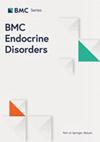妊娠头三个月游离脂肪酸与妊娠糖尿病风险的关系:一项巢式病例对照研究
IF 2.8
3区 医学
Q3 ENDOCRINOLOGY & METABOLISM
引用次数: 0
摘要
越来越多的证据表明,游离脂肪酸(FFA)与妊娠糖尿病(GDM)有关。然而,大多数研究都侧重于几种特定类型的游离脂肪酸,如α-亚麻酸(C18:3n3)和花生四烯酸(C20:4n6)或游离脂肪酸的总水平。这项研究旨在检测妊娠头三个月中各种脂肪酸与患糖尿病风险之间的关系。参与者来自舟山孕妇队列(ZWPC)。研究采用了1:2的巢式病例对照研究:50名患GDM的母亲与100名未患GDM的母亲按年龄、孕前体重指数(BMI)、口服葡萄糖耐量试验(OGTT)月份和胎次进行配对。通过气相色谱-质谱联用仪(GC-MS)检测了孕前三个月母体血浆中的 37 种脂肪酸(包括 17 种饱和脂肪酸 (SFA)、8 种单不饱和脂肪酸 (MUFA)、10 种多不饱和脂肪酸 (PUFA) 和 2 种反式脂肪酸 (TFA))。采用条件逻辑回归模型评估了 FFA 与 GDM 风险的相关性。9种FFA分别与GDM风险增加有关(P < 0.05),4种FFA分别与GDM风险降低有关(P < 0.05)。SFA 风险评分与 GDM 风险增加有关(OR = 1.34,95% CI:1.12-1.60),UFA 风险评分(OR = 1.26,95% CI:1.11-1.44)、MUFA 风险评分(OR = 1.70,95% CI:1.27-2.26)、PUFA 风险评分(OR = 1.32,95% CI:1.09-1.59)和 TFA 风险评分(OR = 2.51,95% CI:1.23-5.13)也与 GDM 风险增加有关。此外,还发现了不同类型的 FFA 风险评分对 GDM 的共同影响。例如,与 SFA 和 UFA 低风险评分的妇女相比,SFA 和 UFA 高风险评分的妇女患 GDM 的风险最高(OR = 8.53,95%CI:2.41-30.24),而 SFA 低风险评分和 UFA 高风险评分的妇女以及 SFA 高风险评分和 UFA 低风险评分的妇女的 Odds ratio 分别为 6.37(95%CI:1.33-30.53)和 4.25(95%CI:0.97-18.70)。妊娠前三个月母体的 FFA 与 GDM 风险呈正相关。此外,FFAs 对 GDM 风险也有联合效应。妊娠头三个月中升高的反式脂肪酸水平会增加患 GDM 的风险。本文章由计算机程序翻译,如有差异,请以英文原文为准。
Association of free fatty acid in first trimester with the risk of gestational diabetes mellitus: a nested case-control study
Accumulating evidence shows that free fatty acids (FFA) are associated with gestational diabetes mellitus (GDM). However, most of the studies focus on a few specific types of FFA, such as α-linolenic acid (C18:3n3) and Arachidonic acid (C20:4n6) or a total level of FFA. This study aimed to test the association between a variety of FFAs during the first trimester and the risk of GDM. The participants came from the Zhoushan Pregnant Women Cohort (ZWPC). A 1:2 nested case-control study was conducted: fifty mothers with GDM were matched with 100 mothers without GDM by age, pre-pregnancy body mass index (BMI), month of oral glucose tolerance test (OGTT) and parity. Thirty-seven FFAs (including 17 saturated fatty acids (SFA), 8 monounsaturated fatty acids (MUFA), 10 polyunsaturated fatty acids (PUFA) and 2 trans fatty acids (TFA)) in maternal plasma during the first trimester were tested by Gas Chromatography–Mass Spectrometry (GC-MS). Conditional logistic regression models were performed to assess the associations of FFA with the risk of GDM. Nine FFAs were respectively associated with an increased risk of GDM (P < 0.05), and four FFAs were respectively associated with a decreased risk of GDM (P < 0.05). SFA risk score was associated with a greater risk of GDM (OR = 1.34, 95% CI: 1.12–1.60), as well as UFA risk score (OR = 1.26, 95% CI: 1.11–1.44), MUFA risk score (OR = 1.70, 95%CI: 1.27–2.26), PUFA risk score (OR = 1.32, 95%CI: 1.09–1.59) and TFA risk score (OR = 2.51, 95%CI: 1.23–5.13). Moreover, joint effects between different types of FFA risk scores on GDM were detected. For instance, compared with those with low risk scores of SFA and UFA, women with high risk scores of SFA and UFA had the highest risk of GDM (OR = 8.53, 95%CI: 2.41–30.24), while the Odds ratio in those with a low risk score of SFA and high risk score of UFA and those with a high risk score of SFA and low risk score of UFA was 6.37 (95%CI:1.33– 30.53) and 4.25 (95%CI: 0.97–18.70), respectively. Maternal FFAs during the first trimester were positively associated with the risk of GDM. Additionally, there were joint effects between FFAs on GDM risk. Elevated FFA levels in the first trimester increased the risk of GDM.
求助全文
通过发布文献求助,成功后即可免费获取论文全文。
去求助
来源期刊

BMC Endocrine Disorders
ENDOCRINOLOGY & METABOLISM-
CiteScore
4.40
自引率
0.00%
发文量
280
审稿时长
>12 weeks
期刊介绍:
BMC Endocrine Disorders is an open access, peer-reviewed journal that considers articles on all aspects of the prevention, diagnosis and management of endocrine disorders, as well as related molecular genetics, pathophysiology, and epidemiology.
 求助内容:
求助内容: 应助结果提醒方式:
应助结果提醒方式:


